The next-gen MacBook Pro with Retina Display Review
by Anand Lal Shimpi on June 23, 2012 4:14 AM EST- Posted in
- Mac
- Apple
- MacBook Pro
- Laptops
- Notebooks
Battery Life
For much of the past year I haven’t been pleased with just how good Apple’s caching has become both on OS X and iOS. Aggressively caching our test web pages produces artificially inflated battery life numbers and that’s no fun for anyone. I’m happy to say that I’ve fixed that problem with our OS X battery life tests.
The suite is completely redone although conceptually it’s quite similar to what I’ve run in the past. I have three separate workloads: light, medium and heavy, each one representing a different stress level on the machine and all three giving you a decent idea of the dynamic range of battery life you can expect from one of these notebooks. All three tests are run with the displays set to 100 nits (a little above the halfway brightness point on most MacBook Pros).
The light and medium suites are inherently related - they use the same workload and simply vary the aggressiveness of that workload. The light test hits four different websites every minute, pausing for nearly the entire time to simulate reading time. Flash is enabled and present on three of the sites. The long pause time between page loads is what really makes this a light test. Web browsing may be the medium for the test but if all you’re doing is typing, watching Twitter update and maybe lazily doing some other content consumption this is a good representation of the battery life you’ll see. It’s a great way of estimating battery life if you’re going to be using your notebook as a glorified typewriter (likely a conservative estimate for that usage model).
The medium test hits the same webpages (Flash and all) but far more aggressively. Here there’s less than 10 seconds of reading time before going onto the next page. It sounds like a small change but the impact on battery life is tremendous.
Both the light and medium tests are run in their default state with processor graphics enabled, as well as with the discrete GPU forced on. I run with the dGPU on as well because it’s far too often that a single application open in the background will fire up the dGPU and contribute to draining your battery. The goal here is to deliver useful numbers after all.
The final test is very similar to our old heavy multitasking battery life tests, but with some updates. Here I’m downloading large files at a constant 1MB/s from a dedicated server, while playing back a looped 1080p H.264 movie (the Skyfall trailer) all while running the medium battery life test. The end result is a workload that gives you a good idea of what a heavy multitasking usage model will do in terms of battery life. I’ve found that OS X tends to fire up the dGPU anyway while running this workload so I saw no reason to run a separate set of numbers for processor and discrete graphics.
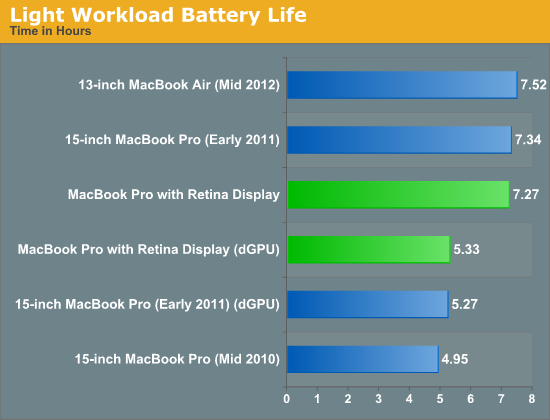
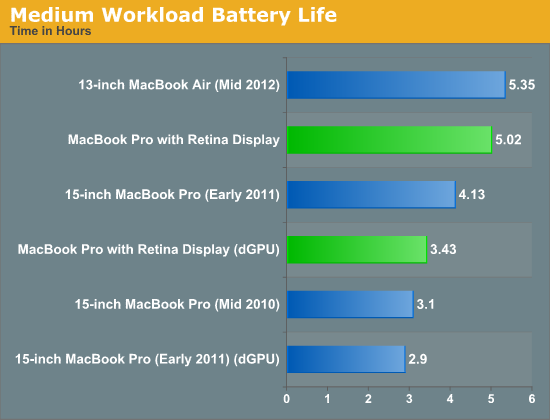
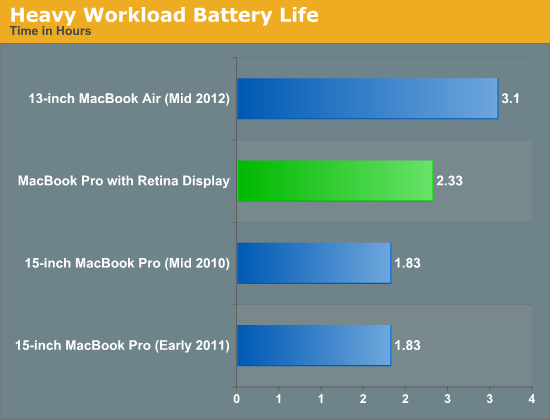
Overall the rMBP pretty much behaves as expected. Apple claims up to 7 hours of battery life and using our light workload we see a bit over that. Fire up the dGPU and even a light workload will get cut down to around 5.5 hours. Moderate usage will drop battery life to around 5 hours, and if you fire up the dGPU you’ll see that cut down to 3.5. The heavy multitaskers in the audience will see a bit above 2 hours out of a single charge. Note that all of these numbers are at 100 nits, drive the 2880 x 1800 panel at its full brightness and you can expect a tangible reduction in battery life.
The rMBP’s integrated 95Wh battery is ginormous by today’s standards, but it’s really necessary to drive both the silicon and that impressive panel. Subjectively I did find the rMBP lasted longer than last year’s MacBook Pro, despite the similar max battery life ratings. My experiences were echoed by the results in our tests.
I suspect most users will see around 5 hours of battery life out of the system compared to a bit under 4 hours out of last year’s machine. At minimum brightness, typing a long document (similar to what I’m doing right now) you can significantly exceed Apple’s 7 hour estimate. As always it really depends on usage model. Professional users doing a lot of photo and video editing aren’t going to see anywhere near the max battery life, while the writers and general users will be quite happy.
One trick to maximizing battery life on light or moderate workloads is to keep an eye on what the discrete GPU is doing. I still find that OS X will wake up the discrete GPU far too frequently, even when in my opinion its services aren’t needed. As always I turn to Cody Krieger’s excellent gfxCardStatus app for keeping an eye on which GPU is driving the panel. The app has been updated and is now fully compatible with the rMBP.


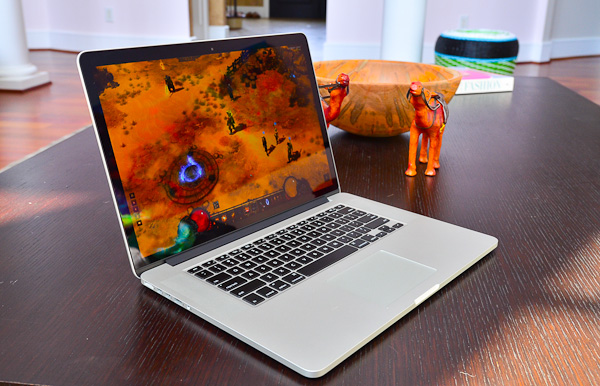
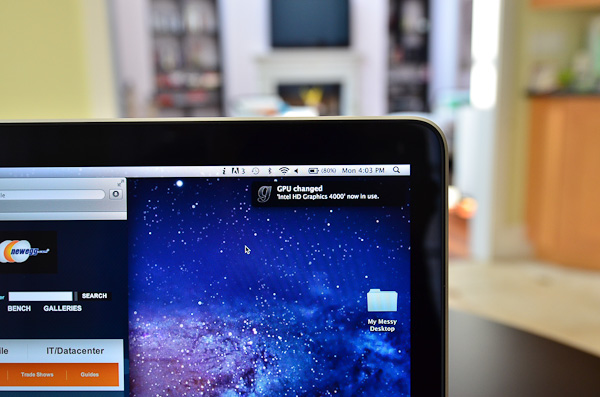








471 Comments
View All Comments
Mumrik - Monday, June 25, 2012 - link
Anand, on page 4 you categorize the rMBP as a consumer device: "At 220 pixels per inch it’s easily the highest density consumer notebook panel shipping today.", but back on page 2 you made a deal of of calling it a pro "appliance" and pointed out that it wasn't a consumer device.
Other than that - this DPI improvement really needs to get moving. It's been so many years and we've essentially been standing still since LCDs took over and the monitor business became a race towards the bottom. IPS, high DPI and native support for it in software PLEASE. 120hz would be nice too.
dwade123 - Monday, June 25, 2012 - link
I don't understand why Apple doesn't take advantage of their lead in Thunderbolt. This machine screams for E-GPU with GTX 670!Spunjji - Tuesday, June 26, 2012 - link
Probably because right now the user experience would be poor. See Anand's comments about sound and USB cutting out when high-bandwidth transfers are occurring. That would be catastrophic mid-game and would definitely lead me to return the hardware as unfit for purpose. Apple have had their slip-ups but they rarely release hardware that is unfit for purpose.inaphasia - Monday, June 25, 2012 - link
Does Apple have some sort of exclusive deal (ie monopoly with an expiration date) on these displays, or can anybody (HP, Asus, Lenovo etc) use them if they want to?wfolta - Monday, June 25, 2012 - link
In recent years, Apple has been the King of the Supply Chain due to Tim Cook. He's now the CEO. I doubt that there will be many retina 15" screens available for Apple's competitors for a year or more.Even if Apple didn't lock up the supply chain, Apple's competitors have been running towards lower resolutions, or the entertainment-oriented 16:9 1920x1080 (aka 1080p), so it will take them a while to pivot towards higher-density displays even if they were growing on trees.
Constructor - Thursday, June 28, 2012 - link
Apple has been paying huge sums (in the Billions of Dollars!) to component manufacturers in advance to have them develop specific components such as this one, even paying for factories to be built for manufacturing exclusively for Apple for a certain time.It is also possible that Apple has licensed certain patents from various (other) manufacturers for their exclusive use which might preclude open-market sales of the same components even after the exclusive deal with Apple is up, because the display manufacturer may not be able to keep using these same patents.
In short: The chances for PC manufacturers to get at them just by waiting for them to drop into the market eventually don't look too good.
After all, none of the other Retina displays have appeared in other products yet. And the iPhone 4 is already two years old.
So either the non-Apple-supplying component manufacturers or the PC builders will have to actually pay for their own development. And given their mostly dismal profit margins and relatively low volumes in the premium segment, I wouldn't hold my breath.
Shanmugam - Monday, June 25, 2012 - link
Anand and Team,Excellent review again.
When is the MacBook Air Mid 2012 review coming? I really want to see the battery life improvement, I can see that it almost tops out at 8Hours for light work load for 13" MBA.
Cannot wait!!!
smozes - Monday, June 25, 2012 - link
Anand states: "[E]nough to make me actually want to use the Mac as a portable when at home rather than tethered to an external panel. The added portability of the chassis likely contributes to that fact though."I work with an external display at home, and given that there are none yet at this caliber, I'm wondering about doing away with the external display and working only with the rMBP. In the past I've always needed external displays for viewing more info, and I'm curious if this is no longer necessary.
Has anyone tried doing away with an external display and just using the rMBP on a stand with a mouse and keyboard? Since the display includes more info than a cinema display, and given healthy eyesight, would this setup be as ergonomic and efficient?
boeush - Monday, June 25, 2012 - link
For several years, I've been using 17'' notebooks with 1920x1200 displays. That resolution had been more than enough for the 17'' form factor; having even such a resolution on a 15'' screen is going overboard, and doing it on an 11'' tablet is just plane bonkers. I don't see the individual pixels on my laptop's screen, and I'd wager neither would most other people unless they use magnifying lenses.I really don't get the point of wasting money on over-spec'ed hardware, and burning energy pushing all those invisible pixels.
I'd rather have reasonable display resolutions matched to the actual physiological capabilities of the human eye, and spend the rest of the cost and power budgets on either weight reductions, or better battery life, or higher computing performance, or more powerful 3G/4G/Wi-Fi radios, etc.
The marketing-hype idiocy of "retina displays" now appears to be driving the industry from one intolerable extreme (of crappy pannels with sup-par resolutions) right into the diametrically opposite insanity -- that of ridiculously overbuilt hardware.
Why can't we just have cost-effective, performance-balanced, SANE designs anymore?
darkcrayon - Monday, June 25, 2012 - link
Reminds me of comments when the 3rd gen iPad screen was introduced. You have a review which both subjectively (from an extremely experienced user) and objectively from tests shows this is the best display ever for a laptop. Yet people ignore all of that and say it's a waste... I think it would be a waste if it didn't actually... You know... Provide a visibly dramatic level of improvement. And its better to make a large jump bordering on "overkill" than to make tiny incremental steps with something like display resolution- fragmentation/etc being what it is,